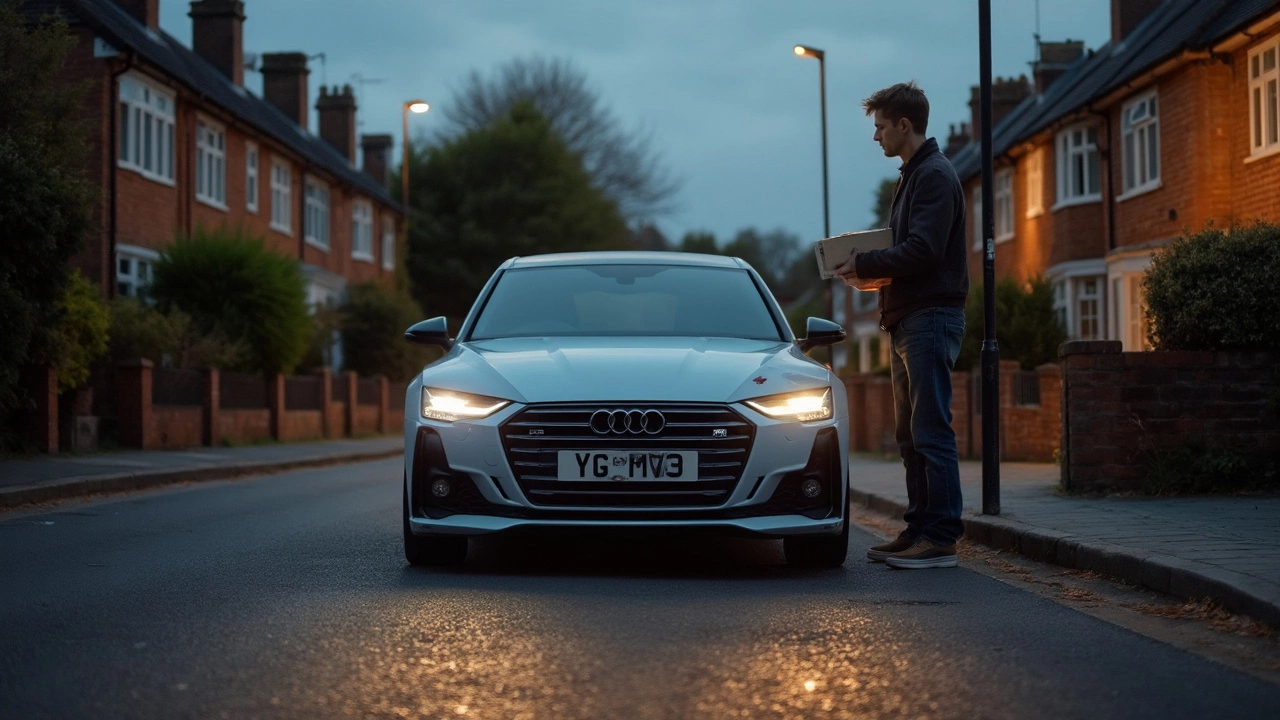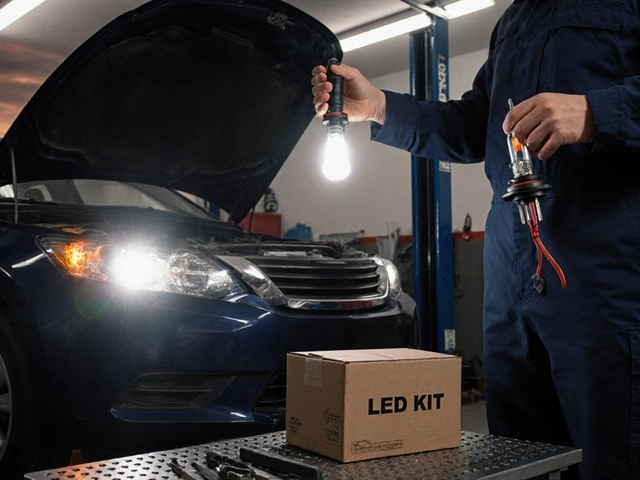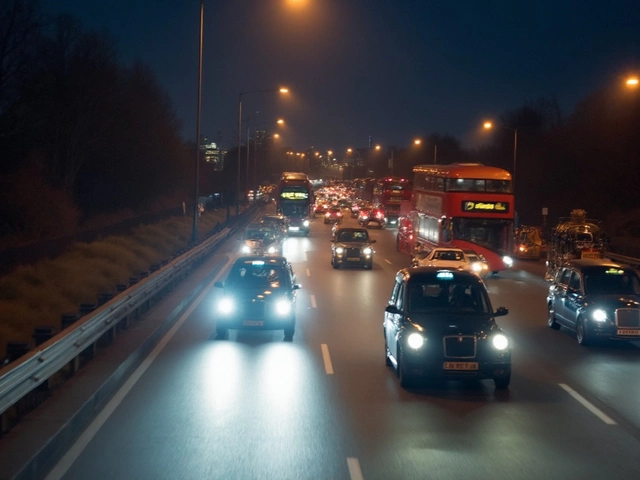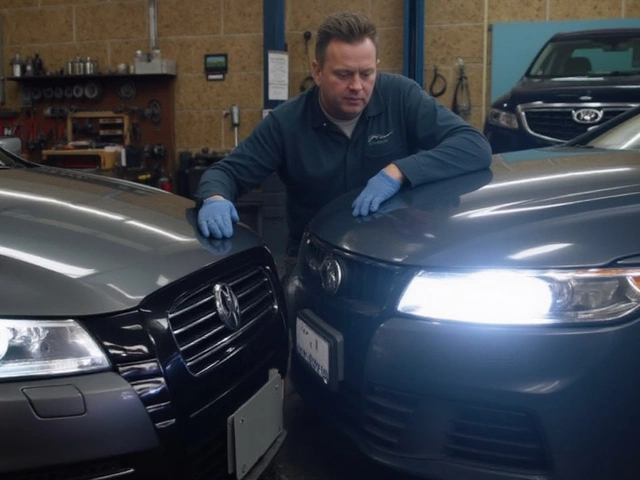Ever driven at night and felt like your headlights might as well be candles? That’s why so many people want to swap those old halogen bulbs for LEDs. LEDs can light up the road way better, with a crisp, white light that actually lets you see where you’re going. Plus, they last a lot longer—so you won’t be stuck with a dead bulb on the side of the road.
But can you actually switch to LEDs just like that? It’s not as simple as grabbing any LED off the shelf and plugging it in. There are legal issues, fit problems, and performance things to think about. The wrong LED can blind oncoming drivers, or even get you in trouble with the law. If you want to make the swap without headaches, you need to know how to pick the right kit and how to install it the right way.
- Why Bother Switching to LED?
- Checking If LEDs Are Legal for Your Car
- What You Need for a Proper Conversion
- Tips for a Smooth Installation
- Avoiding Common LED Headlight Mistakes
- What to Expect After the Switch
Why Bother Switching to LED?
A lot of folks are fed up with dim, yellowish headlights that barely cut it on dark roads. That’s where switching to LED headlights comes in. These aren’t just a trend—they actually fix a bunch of problems you might not even realize you have.
First off, LEDs put out a whiter, brighter beam that helps you spot road signs, animals, and potholes a lot sooner. It’s not just hype—properly installed LEDs can throw light up to 200% farther than some factory halogens. That gives you precious extra seconds to react, especially on those sketchy backroads at night.
Let’s talk about lifespan. Halogen bulbs usually tap out after 500–1,000 hours, but most LED headlight kits are rated for 15,000–30,000 hours. That means less time crawling under the hood and less cash spent on replacements every year. Here’s a look at the numbers:
| Type | Average Lifespan (hours) | Power Consumption (watts) |
|---|---|---|
| Halogen Bulb | ~1,000 | 55–65 |
| LED Bulb | ~20,000 | 20–30 |
See that power difference? LEDs use way less juice, so you’re putting less strain on your car’s electrical system. That can even mean a tiny boost in fuel efficiency, which is a nice bonus if you do a lot of night driving.
- Better visibility (especially in rain and fog)
- Longer life: swap bulbs way less often
- Less energy wasted as heat—LEDs stay cool, which helps nearby parts live longer too
- Faster turn-on: no warmup, just instant full brightness
If you care about looks, LED upgrades also modernize the look of your car. Those crisp white lights just scream "new car" even if you’re rolling a decade-old sedan.
Checking If LEDs Are Legal for Your Car
This is the deal breaker for a lot of people—just because you can buy an LED headlight kit doesn’t mean you’re legally allowed to use it. That trip to a fancy online store isn’t the same as a green light from the cops or the DMV. The rules around LED headlights are a mix of state, national, and sometimes even city laws. In the U.S., headlights have to meet standards set by the Department of Transportation (DOT). In Europe, the equivalent is called ECE (Economic Commission for Europe) regulations.
If your car didn’t originally come with LED headlights, a lot of aftermarket kits are technically “for off-road use only.” That’s usually hidden in small print on the box or deep in the product listing. If a cop pulls you over and it’s clear you’ve got a non-compliant setup, you’re risking a ticket, failed inspection, or even being told to swap back to stock bulbs right there at the roadside.
Here’s what you should do before you buy:
- Check your state’s headlight laws. Some states are tough about aftermarket LED conversions. Others barely check. Google your state plus “LED headlight legal”.
- Look for DOT or SAE markings on the LED kit. This means it’s tested and approved for street use in the U.S.
- Talk to an inspection mechanic (the guys who do annual checks). Ask if they see LED conversions pass or fail.
- If your car is newer and has “projector” style headlights, you usually have a better shot at a clean, legal install—these spread the light better than older reflector housings.
Here’s a quick data breakdown for some major U.S. states and their stance on aftermarket LED headlight conversions:
| State | Status (as of 2025) | Notes |
|---|---|---|
| California | Not allowed unless DOT-compliant | Will fail inspection if non-compliant |
| Texas | Strict | Must emit white or amber; must have DOT marking |
| Florida | Gray area | Rarely enforced but technically must meet DOT/SAE |
| New York | Moderate | Enforced during inspections |
| Illinois | Allowed with DOT/SAE | Check color temperature; blue tint not allowed |
One big tip: If you’re reading an LED headlight product page and there’s no mention of DOT, SAE, or ECE approvals, that’s a red flag. Always double-check before you buy. You don’t want to spend money, look cool for a week, and then have to rip them out before your next inspection.
What You Need for a Proper Conversion
If you want to swap to LED headlights the right way, you’ll need a bit more than just a fancy bulb. It starts with knowing your vehicle’s headlight housing and bulb type—usually marked in your owner’s manual as H4, H7, 9005, or something similar. Just tossing any LED into a halogen housing won’t work; wrong fit leads to terrible light patterns and glares for other drivers.
You’ll need an LED conversion kit made for your specific headlight model. Most kits come with bulbs, heat sinks, and sometimes additional wiring. Good ones include plug-and-play connectors, making your life easier if you don’t want to mess with complicated wiring. If your car has a CAN bus system (pretty common after 2010), you’ll likely need an extra decoder or resistor to avoid those dashboard errors and flickering lights.
Here’s a quick list of what you should have ready before you start:
- Proper LED conversion kit matching your bulb type (like H11, 9006, etc.)
- Compatible wiring adapters or plug-and-play harnesses
- CAN bus decoders/resistors (for newer vehicles)
- Basic hand tools (usually just screwdrivers and hex keys)
- Gloves (to keep oils off bulbs and for handling tight spaces)
If you’re curious about why these extras matter, here’s the basic breakdown:
| Component | Why It's Important |
|---|---|
| LED Kit | Designed for your car's specific housing and wiring |
| CAN bus Decoder | Stops dashboard errors and light flicker in modern cars |
| Adapters | Fits LED bulbs into your existing connectors |
| Heat Sink | Keeps LEDs cool, so they don’t burn out early |
And here’s something most people don’t realize: not all LEDs are street-legal. Look for conversion kits approved by DOT or ECE (it’s usually marked on the box). Legal kits meet strict standards, so you won’t get pulled over, and they won’t blind oncoming traffic. Double-check your local laws—some states in the US have pretty strict rules about headlight swaps.
Lastly, if you want your upgrade to really shine, pay attention to beam alignment. Misaligned LED bulbs can throw light everywhere except where you need it. It’s worth using a flat wall and some tape to aim the beams correctly after the install. No one wants to light up the trees or other drivers’ faces instead of the road.
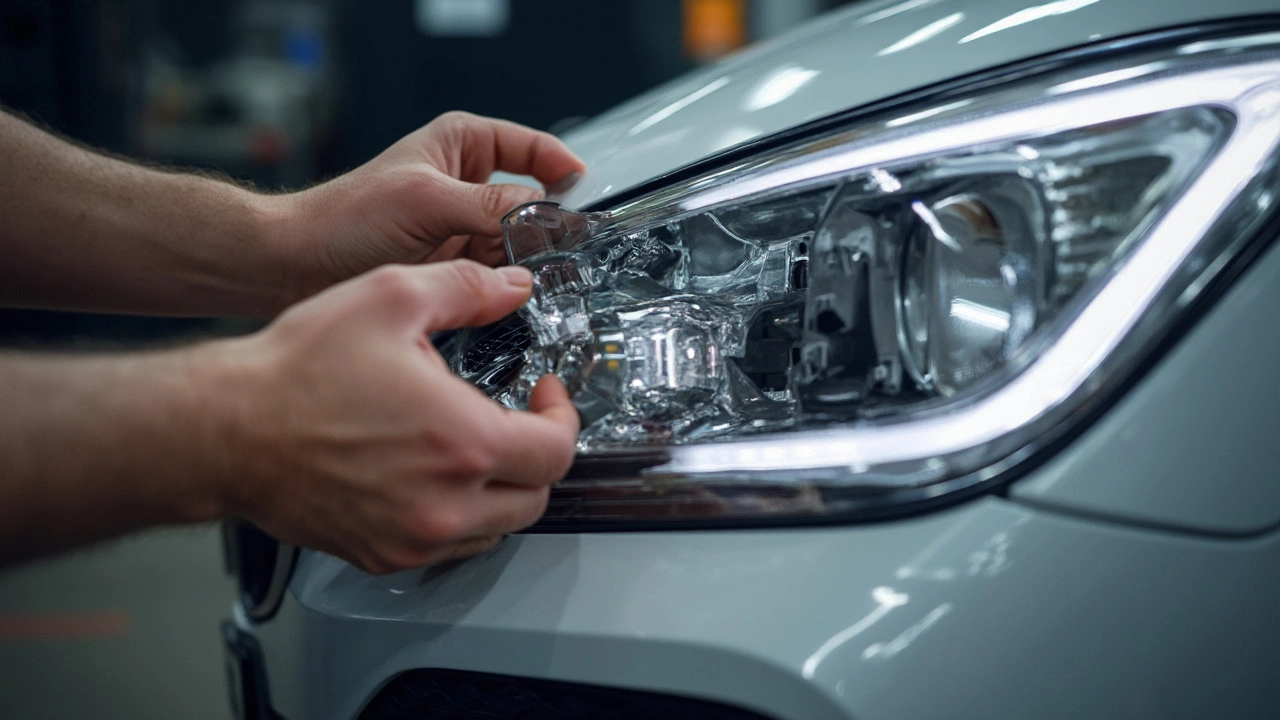
Tips for a Smooth Installation
Switching your old bulbs to LED headlights sounds easy, but there are a few tricks that make the actual job much smoother. First off, never assume all LEDs fit all cars. Always double-check that the LED kit you buy matches your make, model, and year. Sites like Retrofit Source or your car's owner's manual can help with the bulb size.
One step people often forget is to test the LED headlights before you button everything up. Plug them in, turn on your headlights, and make sure both work. You don’t want to reinstall everything just to realize one bulb is a dud.
Some cars, especially European brands, are fussy about anything electrical. If your LED headlights flicker, don't panic—that's common and usually means you need an extra part called a CANbus decoder. These small boxes trick your car so it doesn't throw a ‘bulb out’ warning or flicker the light. Here’s what you might need depending on your vehicle:
| Vehicle Type | Possible Extra Parts Needed |
|---|---|
| Older American (pre-2005) | Usually none |
| Modern European (VW, Audi, BMW) | CANbus decoder, anti-flicker harness |
| Recent Japanese (e.g. Toyota, Honda) | Maybe anti-flicker harness |
Make sure you seat the LEDs correctly. Sounds basic, but if you don’t, the beam pattern will be a mess. Aim the bulbs exactly like halogens. A beam that’s too high can blind other drivers and get you pulled over.
LED headlights often come with a driver or small box attached to the wiring. Don’t cram this into a random spot. Mount it somewhere safe from water and heat, and use zip ties or double-sided tape to keep it from bouncing around.
A pro tip: If your new LEDs have cooling fans, give them some breathing space. Don’t shove them into a cramped housing or the fans might choke and overheat. That kills the bulb faster than you’d think.
"If you want a safer, more effective headlight upgrade, take the time to test and aim your new LEDs. Even the brightest bulb is useless if it’s pointed the wrong way." – Daniel Stern, automotive lighting specialist
Once you finish, test everything in the dark on a flat surface, like your garage door. Check for sharp, clean cut-off lines and make sure your lights aren’t aimed too high. Nothing says "rookie install" like lighting up your neighbor’s bedroom at midnight.
Avoiding Common LED Headlight Mistakes
When switching to LED headlights, a lot of folks run into trouble because they miss key details. Ever see cars with blinding, blue-ish lights that scatter everywhere? That’s one of the most common fails: using the wrong LED bulb for your headlight housing. Halogen housings aren’t always made for the light pattern an LED produces, and that means you might end up making it harder—not easier—to see at night.
Fitment is another big deal. Some drivers buy cheap, universal LED kits on the internet, thinking they’ll fit like factory bulbs. Problem is, not all LED kits match your car’s socket or have the right beam pattern. Always check the bulb size and compatibility with your car’s year, make, and model. As AutoTrader UK puts it:
"LED headlight upgrades are not simple plug-and-play affairs in most cases. Mismatched bulbs can lead to poor light performance and even damage electrical components."
Then there’s the heat issue. LEDs run cooler than halogens, but their drivers and fans generate heat in a small space. If your bulbs overheat because there’s not enough room to breathe, your fancy new lights can burn out fast. Make sure there’s enough clearance behind the headlight cap, or you’ll be swapping bulbs—again—in a few months.
You can also mess up your car’s electrical system if you ignore CANbus systems. Newer cars sometimes throw warning lights or shut off the bulbs completely if the circuit detects low wattage from LEDs. If your dash lights up like a Christmas tree after you swap bulbs, you probably need a decoder or resistor (often called an anti-flicker harness).
Here are a few easy ways to dodge the most common mistakes:
- Get LEDs designed for your exact headlight housing—don’t just buy the cheapest kit.
- Choose LEDs close to the brightness of halogen bulbs, usually between 1,500-2,000 lumens per bulb for most daily drivers. Don’t go overboard—ultra-bright bulbs can be illegal or unsafe.
- Test the light beam after install. Park facing a wall and check the cut-off. If you see a scattered mess instead of a sharp beam, you might have the wrong bulb.
- Install any needed CANbus decoders before buttoning up your headlights, especially on newer vehicles.
- Keep the cooling fans or heat sinks clear of wires or things that might block airflow.
How common are these issues? Here’s a quick look from a survey of auto repair shops in the US that saw LED headlight troubles in 2024:
| LED Headlight Issue | Percentage of Reports |
|---|---|
| Poor beam pattern/glare | 56% |
| Compatibility problems | 22% |
| Overheating/fan failure | 13% |
| Dashboard warning lights | 9% |
If you double-check fitment, beam pattern, and electrical needs before you hit that “buy” button, you’ll save yourself a ton of hassle—and other drivers will thank you for not blinding them at every turn.
What to Expect After the Switch
So you've made the jump—your car’s headlights are now rocking the latest LEDs. What’s life like now? For starters, you’ll notice the brightness the moment you flip that switch. LEDs produce a whiter, more intense beam, making street signs pop and corners less risky. Saying goodbye to that dull yellow light is honestly a game changer. Most drivers say they feel much safer on dark roads since upgrading to LED headlights.
Another thing you’ll see: regular bulb changes are a thing of the past. LEDs can last up to 30,000 hours (sometimes more), compared to 500 to 1,000 hours for standard halogens. Some folks run the same set for years without a hiccup. That’s not just convenient—it saves you money and time.
| Bulb Type | Average Lifespan (Hours) | Energy Consumption (Watts) |
|---|---|---|
| Halogen | 500 - 1,000 | 55 - 65 |
| LED | 15,000 - 30,000+ | 15 - 45 |
Now, here’s the catch—modern LEDs cut down on energy use, so there’s less strain on your electrical system. Your battery will thank you, especially if you do lots of short trips at night and already have a bunch of gadgets plugged in.
If you went for a well-designed kit and lined the bulbs up right, you should get a focused beam (no weird shadows or glare for other drivers). But if you get flashes from other drivers or see odd light patterns, something’s off. Double-check your installation and the headlight aim. Quality matters—a properly installed LED upgrade is almost always worth it.
Expect to get questions from friends, maybe even jealous looks. Plus, you might get fewer tickets—studies in 2023 showed cars with LEDs had up to 20% fewer nighttime accidents, probably because drivers can spot hazards faster. But keep your eyes on any new or changing laws, especially if you live somewhere fussy about mods.
- Bigger and brighter light output
- Way longer lifespan—years, not months
- Less battery drain
- Possibly better safety stats at night
- Make sure you’re aimed right to avoid dazzling other drivers
The bottom line? If you set everything up right and keep things legal, swapping to LEDs can make every night drive easier and safer. Just remember, it’s not usually a set-it-and-forget-it job—double check your angles and check for new updates on local regulations.

